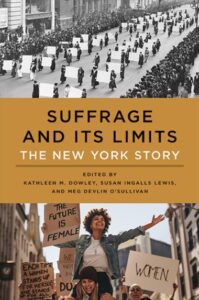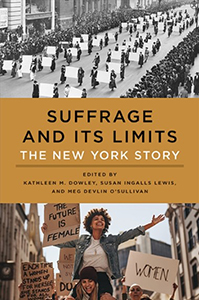SUNY Faculty Collaborate to Publish Suffrage and Its Limits: The New York Story
Suffrage and Its Limits: The New York Story is a collection of articles curated and co-edited by Kathleen M. Dowley, associate professor of political science and international relations; Meg Devlin O’Sullivan, associate professor of history and women’s, gender, and sexuality studies; and Susan Ingalls Lewis, emerita professor of history. The book was originally published in hardcover by SUNY Press in September 2020 and has just been released in paperback in January 2021.

The book provides a sampling of a wide range of issues offering readers insight into the struggle for women’s suffrage alongside related issues of equality. The book is divided into three sections – past, present, and future with a preface by New York State Lieutenant Governor Kathy Hochul. The format mirrors that of the conference which inspired the book, and its contributors represent a range of participants, from academic scholars to activists to politicians.
The first section, titled “Investigating the Past”, provides a granular history from multiple perspectives of the fight for women’s suffrage in New York state. Including chapters by Susan Goodier and Karen Pastorello, Julie A. Gallagher, Joanna L. Grossman, and O’Sullivan and Lewis. The first chapter of the book written by Goodier and Pastorello, is a condensed version of their own book Women Will Vote: Winning Suffrage in New York State and focuses on the importance of the New York women’s suffrage movement to the national fight for women’s voting rights. The story of women’s suffrage in New York is especially important because as each state passed laws legalizing the vote for women, it expanded the base of supporters for a national movement. Lewis argues that if not for the passage of women’s suffrage in New York, the passage of the Nineteenth Amendment to the U.S. Constitution, prohibiting restriction of voting rights based upon sex, would not have been ratified in 1920.
Lewis quotes political strategist and communicator, Ann C. Frank Lewis, saying, “Women’s suffrage is the largest expansion of democracy on any single day on our nation’s history.”
The second section, “Interrogating the Present”, explores civic participation alongside issues such as racism and workplace sexual harassment, which remain unresolved long after women earned the right to vote. This section includes chapters by Kira Sanbonmatsu, kt Tobin, director of the Benjamin Center for Public Policy Initiatives at SUNY New Paltz, Eve Walter and Dowley.
The third section, “Imagining the Future,” extrapolates what present conditions might look like in the future including issues of care work, the perspective of the American black woman’s struggle for political and social change and the value of intersectional movements for substantive social and political change. This section includes chapters by Amy R. Baehr, Jasmine Syedullah, Gabrielle Baron-Hill and Barbara Smith.
The origins of Suffrage and Its Limits
The book Suffrage and Its Limits first began in 2013 as a blog by Lewis, who wanted to explore the history of the women’s suffrage movement in light of the approaching 100th anniversary of women earning the vote in New York state. Gerald Benjamin, then director of the Benjamin Center, proposed the idea for holding a conference. Dowley joined the planning committee for the conference in its early stages, with O’Sullivan joining shortly thereafter.
The conference consisted of a two day event that took place on April 21-22, 2017 and was hosted by The Benjamin Center for Public Policy Initiatives, in collaboration with the departments of history, political science and international relations and women’s, gender, and sexuality studies; The Rockefeller Institute of the State University of New York; the FDR Library; and the League of Women Voters of New York State. First night presentations took place at the FDR Library in Hyde Park with panels and discussion sessions on the SUNY New Paltz campus.
As in the book, the structure for the conference was an exploration of the past, present and future and asked the questions: How did women get the vote? What did they do with the vote? What are the limitations of this win? And what is the program for the future?
Speakers and presenters included U.S. Senator Kirsten Gillibrand, Dr. Wylecia Wiggs Harris, executive director of the League of Women Voters of the United States, Allida Black, professor of History/International Relations at George Washington University and editor of the Eleanor Roosevelt Papers, and Barbara Smith, black feminist, lesbian, activist, author, and publisher of work by women of color.
While the conference was in the planning stages, the assumption that attendees would be celebrating the country’s first female President with the election of Hillary Rodham Clinton prevailed. Though the reality was a Donald Trump victory, Lewis said the mood of the conference remained surprisingly encouraging and filled with a spirit of determination, which mimicked the history of the fight for suffrage, which was not an unbroken linear progression towards the right to vote but, rather, a struggle peppered with setbacks and disappointments along the way. In describing the mood of the conference in the wake of Clinton’s defeat, Lewis recognized women “. . . who were still fighting, who had not given up, who were going to push on, who were challenged but not defeated.”
“And that is the story of suffrage,” she said.
With the success of the conference, Dowley encouraged the idea of adapting the concepts presented in the conference into book form to reach a wider audience. A guiding refrain for all in the planning stages between conference and book was to move past the celebratory notions associated with the most visible figures of the women’s suffrage movement, Elizabeth Cady Stanton and Susan B. Anthony, and to instead provide a more focused lens on exploring and analyzing the conditions present for the successful passage of women’s suffrage rights. Rather than another celebration of women getting the vote, the organizers endeavored to create a more analytical collection of suffrage stories. Lewis was very interested to figure out what worked and why within the history of the suffrage movement and to provide a more realistic appraisal of the movement.
“We could use a little less celebration and a little more analysis. With analysis you have a basis for future action,” she noted.
In the introduction to the final chapter of the book containing Barbara Smith’s keynote speech from the conference, Smith is quoted as saying “The way forward is to be engaged in freedom organizing that does not merely address the symptoms of oppression, but that also comprehends and challenges the reasons for it.”
We an eye toward informing and shaping the future, this book could find its way into junior high, high school and college classrooms across the state, though it is also appropriate for a non-academic audience.
“I think this book should be required reading for all members of the New York state legislature,” Lewis said.

